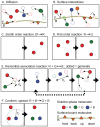Detailed simulations of cell biology with Smoldyn 2.1
- PMID: 20300644
- PMCID: PMC2837389
- DOI: 10.1371/journal.pcbi.1000705
Detailed simulations of cell biology with Smoldyn 2.1
Abstract
Most cellular processes depend on intracellular locations and random collisions of individual protein molecules. To model these processes, we developed algorithms to simulate the diffusion, membrane interactions, and reactions of individual molecules, and implemented these in the Smoldyn program. Compared to the popular MCell and ChemCell simulators, we found that Smoldyn was in many cases more accurate, more computationally efficient, and easier to use. Using Smoldyn, we modeled pheromone response system signaling among yeast cells of opposite mating type. This model showed that secreted Bar1 protease might help a cell identify the fittest mating partner by sharpening the pheromone concentration gradient. This model involved about 200,000 protein molecules, about 7000 cubic microns of volume, and about 75 minutes of simulated time; it took about 10 hours to run. Over the next several years, as faster computers become available, Smoldyn will allow researchers to model and explore systems the size of entire bacterial and smaller eukaryotic cells.
Conflict of interest statement
The authors have declared that no competing interests exist.
Figures




References
-
- Alves R, Antunes F, Salvador A. Tools for kinetic modeling of biochemical networks. Nat Biotechnol. 2006;24:667–672. - PubMed
-
- Delbrück M. The burst size distribution in the growth of bacterial viruses (bacteriophages). J Bact. 1945;50:131–135. - PubMed
-
- Berg HC, Brown DA. Chemotaxis in Escherichia coli analysed by three-dimensional tracking. Nature. 1972;239:500–504. - PubMed
-
- Colman-Lerner A, Gordon A, Serra E, Chin T, Resnekov O, et al. Regulated cell-to-cell variation in a cell-fate decision system. Nature. 2005;437:699–706. - PubMed
Publication types
MeSH terms
Substances
Grants and funding
LinkOut - more resources
Full Text Sources
Molecular Biology Databases

